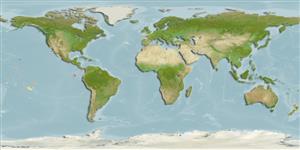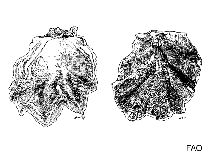Crassostrea corteziensis (Hertlein, 1951)
Cortez oyster| Native range | All suitable habitat | Point map | Year 2050 |

|
| This map was computer-generated and has not yet been reviewed. |
| Crassostrea corteziensis AquaMaps Data sources: GBIF OBIS |
Upload your photos
Google image | No image available for this species;
drawing shows typical species in Ostreidae.
Google image | No image available for this species;
drawing shows typical species in Ostreidae.
Classification / Names Common names | Synonyms | CoL | ITIS | WoRMS
Bivalvia | Ostreida | Ostreidae
Environment: milieu / climate zone / depth range / distribution range Ecology
Benthic; brackish; depth range 1 - 2 m (Ref. 101353). Temperate
Distribution Countries | FAO areas | Ecosystems | Occurrences | Introductions
Eastern Central Pacific and Northeast Atlantic: Mexico, Panama and UK.
Length at first maturity / Size / Weight / Age
Maturity: Lm ? range ? - ? cm Max length : 25.0 cm SHL male/unsexed; (Ref. 101485)
Depth range is based on occurrence in Mexico (Ref. 101353); to be replaced with a better reference. Mostly inhabits the intertidal zone (Ref. 106881). Found in mangroves (Refs. 101351, 106881), estuaries and coastal lagoons associated with mangrove roots (Ref. 106881). Eurythermal and euryhaline (Ref. 106881).
Life cycle and mating behavior Maturity | Reproduction | Spawning | Eggs | Fecundity | Larvae
Members of the class Bivalvia are mostly gonochoric, some are protandric hermaphrodites. Life cycle: Embryos develop into free-swimming trocophore larvae, succeeded by the bivalve veliger, resembling a miniature clam.
Main reference
References | Coordinator | Collaborators
The British Flora and Fauna Database. 2007. (Ref. 8593)
IUCN Red List Status (Ref. 130435)
CITES status (Ref. 108899)
Not Evaluated
CMS (Ref. 116361)
Not Evaluated
Threat to humans
Human uses
Fisheries: commercial
FAO - Aquaculture: production; | FishSource | Sea Around Us
Tools
More information
Internet sources
BHL | BOLD Systems | CISTI | DiscoverLife | FAO(; publication : search) | Fishipedia | GenBank (genome, nucleotide) | GloBI | Gomexsi | Google Books | Google Scholar | Google | PubMed | Tree of Life | Wikipedia (Go, Search) | Zoological Record
Estimates based on models
Preferred temperature
(Ref. 115969): 12.4 - 26.9, mean 19 (based on 123 cells).
Resilience
(Ref. 69278):
High, minimum population doubling time less than 15 months (K=1.08-1.1).
Nutrients: Calcium = 149 [71, 228] mg/100g; Iron = 8.53 [1.95, 15.11] mg/100g; Protein = 9.88 [8.64, 11.12] %; Omega3 = 0.313 [0.202, 0.423] g/100g; Selenium = 61 [50, 72] μg/100g; VitaminA = 0 μg/100g; Zinc = 2.04 [0.56, 3.51] mg/100g (wet weight).



